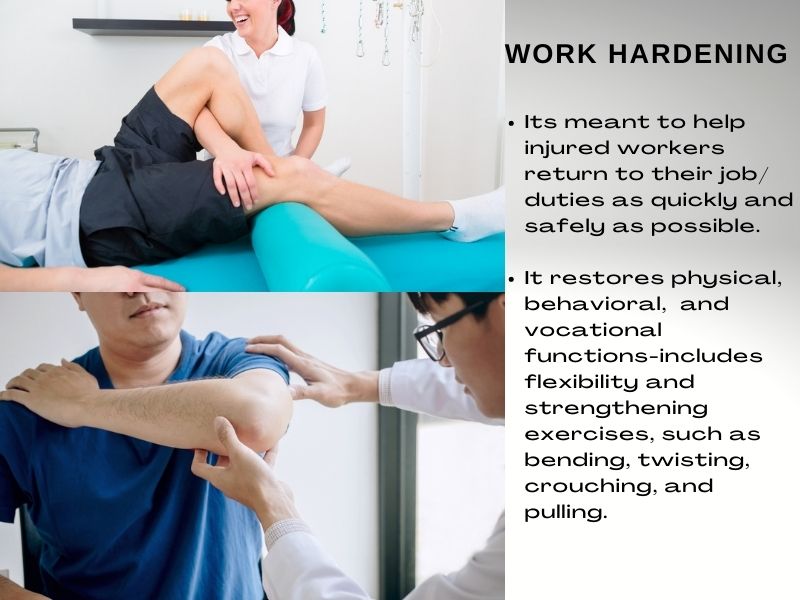Workplace injuries are common in every industry. They’re especially prevalent for those who work physically demanding jobs. A workplace injury could mean time off from work and a loss of income. Recovering from such injuries can be a daunting task. Depending on the level of injury, your doctor may recommend either work conditioning or hardening as part of the rehabilitation to prepare your body and mind to return to work.
Work conditioning takes a physical approach to prepare workers to return to the workplace in their pre-injury state. Work hardening is a holistic approach that targets mental preparedness, safety standards reinforcement, and personal confidence. Both programs are run simultaneously to ensure the worker returns to work feeling secure in body and mind.
What is work hardening?
Work hardening is a therapy program designed to help the injured worker return to their previous job duties as quickly and safely as possible. The program is usually conducted in an outpatient setting but can also be done in a hospital if necessary.

The work hardening program helps patients regain their tasks’ cardiovascular, neuromuscular, biomechanical, metabolic, and psychosocial functions.
Work hardening uses a team of professionals to target critical areas of improvement. These teams may include the following professionals:
- Occupational therapists
- Vocational Specialist
- Psychologist
- Physical therapist
The worker is put through a sequence of activities to restore physical, behavioural, and vocational functions. It includes flexibility and strengthening exercises like bending, twisting, crouching, and pulling.
Work hardening requires a time commitment by the professionals and the injured worker. It typically lasts between 6 to 8 hours a day. The program helps build individuals’ stamina to tolerate a full day’s work when they return to their job. It is also a practical way to reinforce positive patterns like regular attendance.
Besides helping workers return to work with reduced pain, work hardening helps improve their mental health and reduce chronic or permanent disability among injured employees.
Who needs work hardening?
Work hardening is ideal for those who have suffered an injury that has caused them to miss work for more than two weeks. The program is recommended when the injured worker’s job requires heavy lifting, repetitive motions, or other strenuous activities. It helps employees to safely return to their previous job duties without fear of re-injury.
What is work conditioning?
Work conditioning is a rigorous program designed to help injured workers return to their jobs quickly and safely. The program involves physical therapy and education, and job-specific training.

This therapy enhances the employee’s endurance, strength, and flexibility to complete essential work duties. It also aims to prevent re-injury while alleviating any possible fear of returning to work.
Work conditioning programs include activities such as:
- Learning about safe body movement patterns
- Learning about injury prevention
- Practising simulations of work-tasks
- Completing strength, flexibility, and endurance exercises
The program’s length varies depending on the injured worker’s needs. Work conditioning typically lasts 2-6-hours per session, 2-5 days per week, for 3 to 8 weeks. The timeframe in the work conditioning program will also depend on the patient’s needs and factors such as the manager’s approval and the work hours. The program’s success relies on the employee’s active participation.
The set time reacclimates the patient with general workplace habits such as punctuality.
Who needs work conditioning?
Work conditioning is recommended for employees who have not worked for an extended period due to injury. It can benefit workers returning to work after an extended leave of absence. The program often helps workers ease back into their jobs and avoid further injuries.
Work conditioning is also recommended for employees who have been working but are at risk of re-injury or have job-related pain. The program can help these workers by teaching them how to safely perform their duties and avoid further injury.
Work conditioning vs. work hardening; Differences and similarities
Work conditioning and work hardening have one standout difference. Work conditioning focuses on repetitive physical tasks that imitate work conditions, while work hardening emphasizes a single task to help the individual get used to the work environment.
While both programs have unique differences, it is also essential to note their similarities. They include the following;
- Both programs help injured workers return to their jobs safely.
- Both programs involve physical therapy and education.
- Both programs require a significant time commitment.
- Both programs are interdisciplinary.
Work conditioning and hardening are effective programs to help injured workers return to their jobs. However, each program has unique benefits and drawbacks. Choosing the right program for your business highly depends on the needs of your employees.
A physical therapist is the best-placed professional adviser to help you evaluate if a worker needs work hardening or work conditioning.
